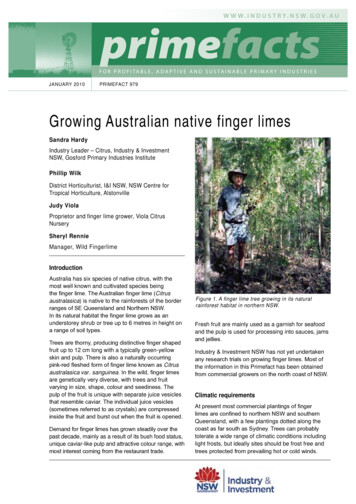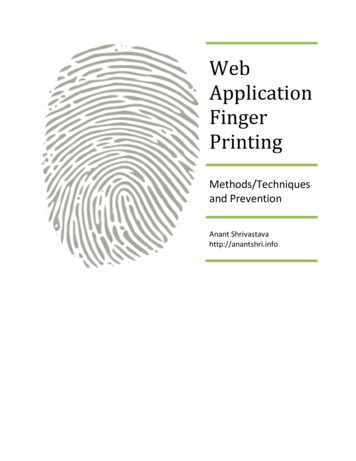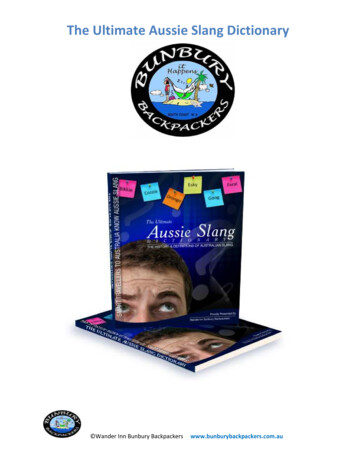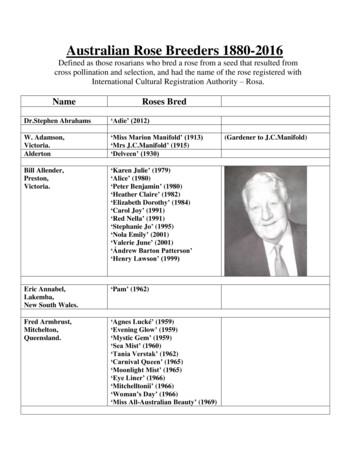
Transcription
W W W . i n d u s t r y. NS W . G O V . A UprimefactsF O R P R O F I TA B L E , A D A P T I V E A N D S U S TA I N A B L E P R I M A R Y I N D U S T R I E SJanuary 2010PrIMeFACT 979Growing Australian native finger limesSandra HardyIndustry Leader – Citrus, Industry & InvestmentNSW, Gosford Primary Industries InstitutePhillip WilkDistrict Horticulturist, I&I NSW, NSW Centre forTropical Horticulture, AlstonvilleJudy ViolaProprietor and finger lime grower, Viola CitrusNurserySheryl RennieManager, Wild FingerlimeIntroductionAustralia has six species of native citrus, with themost well known and cultivated species beingthe finger lime. The Australian finger lime (Citrusaustralasica) is native to the rainforests of the borderranges of SE Queensland and Northern NSW.In its natural habitat the finger lime grows as anunderstorey shrub or tree up to 6 metres in height ona range of soil types.Trees are thorny, producing distinctive finger shapedfruit up to 12 cm long with a typically green-yellowskin and pulp. There is also a naturally occurringpink-red fleshed form of finger lime known as Citrusaustralasica var. sanguinea. In the wild, finger limesare genetically very diverse, with trees and fruitvarying in size, shape, colour and seediness. Thepulp of the fruit is unique with separate juice vesiclesthat resemble caviar. The individual juice vesicles(sometimes referred to as crystals) are compressedinside the fruit and burst out when the fruit is opened.Demand for finger limes has grown steadily over thepast decade, mainly as a result of its bush food status,unique caviar-like pulp and attractive colour range, withmost interest coming from the restaurant trade.Figure 1. A finger lime tree growing in its naturalrainforest habitat in northern NSW.Fresh fruit are mainly used as a garnish for seafoodand the pulp is used for processing into sauces, jamsand jellies.Industry & Investment NSW has not yet undertakenany research trials on growing finger limes. Most ofthe information in this Primefact has been obtainedfrom commercial growers on the north coast of NSW.Climatic requirementsAt present most commercial plantings of fingerlimes are confined to northern NSW and southernQueensland, with a few plantings dotted along thecoast as far south as Sydney. Trees can probablytolerate a wide range of climatic conditions includinglight frosts, but ideally sites should be frost free andtrees protected from prevailing hot or cold winds.
are not always true to type, are slower growing andcan take many years to bear fruit. All commercialcitrus trees are grown on specially selected citrusrootstocks that have different characteristics includingtolerance to a range of soil, disease, pest and climaticconditions.The commercially available finger lime cultivars comein a variety of tree shapes and sizes, from tall uprighttrees with open canopies and narrow leaves to denseweeping shrubs with broader leaves. The mature fruitrange in size from 6 to 12 cm in length and come in awide range of colours including green, yellow, purpleand pink to bright red. The pulp of the fruit is uniquewith a ‘caviar like’ appearance that also comes in awide range of colours. The intensity of skin and pulpcolour can have some variation as a result of floweringtimes and climatic conditions. Fruit seediness can alsovary with some cultivars being almost seedless andothers having many seeds.Figure 2. The Australian native finger lime tree with itsunique finger-shaped fruit.Commercial finger lime orchards do well planted in fullsun. Some earlier plantings, however, incorporatedprotection from full sun by inter-planting with tallernative trees or covering trees with shade cloth, tomimic the natural habitat of the plant.Varieties and rootstocksOver the past twenty years growers and nurserymenhave selected a range of finger lime plants withdifferent characteristics directly from the bush or fromseedling populations. These selections have thenbeen used as the ‘mother plants’ for vegetativelypropagating identical new plants.All commercial citrus trees in Australia are propagatedvegetatively using budwood, which ensures the newtrees are identical to the original mother plant. Citrustrees grown from seed are not used because theyFigures 4 & 5. Finger limes are naturally variable andselected cultivars come in a wide variety of skin (top)and pulp colours (bottom).Figure 3. A commercial finger lime orchard on the northcoast of NSW.2primefact 979, Growing Australian native finger limesFigure 6. The foliage of finger limes is also variable.
Figure 7. Seed number varies with cultivar – thisselection has many seeds.The health status of most of the commerciallyavailable finger lime cultivars is largely unknown asthey have not been tested by the Australian CitrusPropagation Association Incorporated (Auscitrus).Auscitrus budwood trees are regularly tested toensure freedom from exocortis, psorosis and othergraft transmissible pathogens. Currently Auscitrusmaintains mother trees of Citrus australasica var.sanguinea ‘Rainforest Pearl’ as well as the cultivarsC. australasica ‘D1’ and ‘Ruby’ in their insect proofrepository.At present there are a number of finger lime selectionsavailable and commercially grown. These selectionsfall into the following categories.1. Varieties registered with Plant BreedersRights (PBR). PBR varieties are protected andadministered under the Plant Breeders Rights Act1994. In order to be granted PBR the applicantmust show that the new variety is distinct fromall other varieties, is uniform and is stable incultivation. PBR is granted for 25 years for treeand vine varieties. These varieties can only bepropagated under licence from the owner of thatvariety.At present there is only one finger lime varietyprotected by PBR. It is owned by A T Eyles & Sonscitrus nursery at Kenthurst, NSW.Figure 8. The finger lime variety ‘Rainforest Pearl’ isregistered with PBR.plants mean plants raised in cultivation which differsufficiently from their wild ancestors or if takeninto cultivation from the wild are worthy enough ofdistinction from wild populations to merit specialnames. The main purpose of registering a cultivar is toensure that its registered name is retained when it issold or propagated.At present there are five finger lime cultivarsregistered with ACRA and two awaiting registration.These cultivars have been registered by Judy Viola,a finger lime grower and citrus nurserywoman fromBangalow on the north coast of NSW. More detaileddescriptions of these cultivars are available on theACRA website at www.anbg.gov.au/acraThese cultivars include: Citrus australasica ‘Alstonville’ – a tall growingshrub producing dark green-black fruit with a palegreen flesh. (Figure 9) Citrus australasica ‘Blunobia Pink Crystal’ – acompact medium shrub producing green-brown fruitwith a deep pink flesh. Citrus australasica var. sanguinea ‘RainforestPearl’ – a small open upright tree producinggreen fruit tinged with crimson with a pink flesh.(Figure 8.) This variety has been widely planteddue to its long-term commercial availability. Itis grown under licence and available from A TEyles citrus nursery in Kenthurst NSW, Birdwoodnursery in Qld and Citrees nursery in WA.2. Cultivars that have been registered withthe Australian Cultivar Registration Authority(ACRA). ACRA is the International RegistrationAuthority for Australian plant genera. A cultivar isthe basic grouping for cultivated varieties. CultivatedFigure 9. The finger lime cultivar ‘Alstonville’ isregistered with ACRA.primefact 979, Growing Australian native finger limes3
Citrus australasica ‘Durhams Emerald’ – a mediumopen shrub producing black fruit with an emeraldgreen pulp. Citrus australasica ‘Judy’s Everbearing’ – a tallshrub producing green-brown to maroon fruit with agreen to dark pink flesh (Figure 10). Citrus australasica ‘Pink Ice’ – a medium growingshrub producing reddish maroon fruit with a clear topink flesh (Figure 11).Figure 10. The finger lime cultivar ‘Judy’s Everbearing’ isregistered with ACRA.The Finger Limeing Good company uses thefollowing names for their selections: Limeburst opaque, Limeburst green, Limeburst pink,Limeburst burgundy and Limeburst yellow.Descriptions can be found on the company’swebsite, www.fingerlime.com. Eyles citrus nursery also has two other fingerlime selections available to industry including:‘D1’ – A seedless selection with a green/yellowskin and green pulp (Figure 12) and ‘Ruby’ acopper skinned selection with a dark pink pulp.More information is available at www.eylescitrus.com.au.Although no formal rootstock trials have beenundertaken for finger limes they are most commonlybudded onto Citrus trifoliata or Troyer citrangerootstocks. To date no obvious incompatibility onthese rootstocks has been reported. C. trifoliata isthe preferred rootstock for heavy clay-loam soils or inareas with high or frequent rainfall. Most finger limesgrown in coastal areas are budded onto C. trifoliatafor protection against Phytophthora root rot. Rootstockchoice should always match soil and climaticconditions.Figure 12. The finger lime cultivar ‘D1’.Orchard design, tree and crop managementFigure 11. The finger lime cultivar ‘Pink Ice’ is registeredwith ACRA.3. Other cultivarsSome nurserymen, growers and marketing groupshave sourced and named their own finger limeselections which they propagate and sell.Examples include: Two marketing groups on the north coast of NSWhave their own finger lime selections that theygrow and provide to their grower members.The Wild Fingerlime group uses the followingnames for their selections: Rainforest Ruby 1,Rainforest Garnet 1, Rainforest Jade 1 & 2 andRainforest Diamond. Descriptions can be foundat www.wildfingerlime.com.4primefact 979, Growing Australian native finger limesOrchard design. All citrus trees prefer well drainedsoils with a pH of between 5 and 6.5. In areas withhigh rainfall or on heavier soils, trees should bebudded onto C. trifoliata rootstock and tree rowsmounded to help improve drainage during wetweather. Trees should not be planted on soils thatare not free-draining, particularly in prolonged wetweather.It is important to establish windbreaks prior to plantingto protect trees from prevailing winds as the fruitare very susceptible to wind rub and skin damage.Because finger limes are naturally very thorny, the fruitare easily damaged by the thorns which cause thefruit to be downgraded or unsaleable on the fresh fruitmarket.Trees should be planted in spring after the threat offrosts has passed. In warmer areas trees can alsobe planted in autumn. Trees are generally slow to
establish and for the first 12 months after plantingthere is little sign of any growth. Applying mulcharound young trees will help to retain soil moisture andkeep roots cool. Keep the mulch well away from thetree trunk to prevent collar rot. Removing fruit for thefirst three years after planting will help to improve treegrowth and establishment.Most commercial plantings use a hedgerow systemwith the tree rows running in a north-south directionto maximise light interception. Planting densities varywith cultivar, but spacings of 2.5–3 m between treesand 4–5 m between rows are common. This equatesto around 600 to 800 trees/ha. It is best to plant onlythe one cultivar of finger lime within a row for easiermanagement and harvest operations. The numberof trees planted and cultivar selection should alwaysbe based on market requirements. Most commercialplantings are 100–300 trees.Figure 14. Finger limes start to bear larger quantities offruit after 5–6 years.or windy conditions. Some thinning of fruit clustersto improve fruit size is undertaken on heavy settingcultivars.Figure 13. Windbreaks and irrigation are essential forestablishing new orchards.Flowering and cropping. Grafted finger lime treesbegin fruiting in year three but larger quantities of fruitare not normally obtained until year six, when treesare classed as ‘bearing’. Seedling trees can take up to15 years to produce fruit, depending on cultivar. Mostcultivars consistently bear fruit every year; however,some cultivars are prone to biennial bearing and a fewtend to crop up to 3 times a year.On the north coast of NSW flowering starts in Juneand extends through to early October, dependingon cultivar. In warm coastal regions trees may alsoflower sporadically throughout spring and summer.Depending on climatic conditions and cultivar, fruitmature between December and May, with the mainharvest period occurring between March and May.Fruit are selectively picked every 10–14 days over a6–8 week period depending on tree age and cultivar.Finger limes have a fruit development period ofaround 5 months from flowering to harvest. As withother citrus varieties natural fruit drop will occur earlyin the season as the tree sets more fruit than it cancarry and fruit may also be shed during very hot, dryYields vary with cultivar, but well managed 5–6 yearold trees can produce up to 20 kg annually. It isimportant to remember that only about 40% of thefruit produced will be 1st grade/export quality, with theremaining fruit being either 2nd grade or processingquality. Finger lime trees because of their habit andthorniness tend to have a high percentage of 2ndgrade or processing fruit. Fruit range in size from6–12 cm and individual fruit can weigh up to 60 g.Nutrition. No specific research work has beenundertaken on tree nutrient requirements, howeverfinger limes are reported to require a lot less fertiliserthan other commercial citrus varieties. This is probablydue in part to less demand by the tree because of itsnaturally smaller leaves and canopy area. Growersare using only about 25–30% of the total annualamount of NPK fertiliser applied to other commercialcitrus varieties. Depending on growing conditions theroots of finger limes in cultivation tend to have a morefibrous root system with the majority of feeder rootsusually in the top 30–60 cm of soil.A complete NPK (15:4:11) fertiliser low in phosphorousis currently being used by commercial growers. Nofertiliser should be applied from flowering up untilfruit are 1 cm long, otherwise fruit have a tendencyto abort. Some growers apply foliar fertilisers to treesprior to flowering if required. It is best to apply fertiliserprimefact 979, Growing Australian native finger limes5
Figure 15. Grasshopper feeding damage on fruit.Figure 17. Katydids also feed on the fruit of finger limes.in small amounts 2–3 times throughout the growingseason. Be careful not to over-fertilise trees asdieback has been reported to occur.to minimise wind rub by the thorny branches whichcan pierce the fruit. Skirting of the lower branches willkeep fruit off the ground and also help with under-treemanagement operations. Beware of pruning treesin hot weather because sparse foliage on trees maymean that developing fruit are more susceptible tosunburn.Irrigation: Trees should be irrigated to ensureadequate water is available throughout the growingseason, especially at flowering and fruit set and duringthe fruit growth period. Most growers use drip irrigationand allow for 3–5 ML water/ha. Only use good qualityirrigation water – be sure to check water pH andsalinity levels periodically. Soil moisture monitoringequipment such as tensiometers should be installed inthe orchard to help schedule irrigation correctly so asnot to under- or over-water trees.Pruning. Trees respond to regular light pruning. Iffinger lime trees are heavily pruned they may die,especially older woody trees. Young trees onceestablished should be lightly pruned to encouragean open tree shape with 4–6 main branches. Anyvigorous water shoots and rootstock suckers shouldbe removed. As trees mature, light pruning is usuallyundertaken annually in autumn (after harvest) to renew fruiting wood and keep trees at a manageableheight. Pruning also opens up the tree canopy andimproves air circulation and fruit quality by helpingFigure 16. Bronze orange bugs feed on young newshoots causing them to dieback.6primefact 979, Growing Australian native finger limesPests, diseases and other disordersThe main pests of commercial finger limes aresimilar to those affecting other citrus varieties. Pestscommonly found causing damage include scaleinsects, spined citrus bug, bronze orange bug,aphids, mealybugs, caterpillars, snails, katydidsand grasshoppers. Some preliminary research workundertaken by Industry & Investment NSW showedthat fruit do not appear to be a host for Queenslandfruit fly. Rats attracted to birds nesting in trees are alsoreported to damage fruit.The main disease affecting finger limes is melanose(Diaporthe citri), a fungal disease that causes darkbrown to black spots on the foliage, twigs and fruit.Spores of the fungus develop in dead citrus tissueand are released by water and/or rainfall. Thefungus affects all citrus varieties and the incidenceof melanose usually increases as trees age andthe amount of dead wood in the canopy increases.Annual light pruning should aim to remove any deadwood. Experienced finger lime growers recommendnot applying any chemical sprays whilst the trees areflowering as the flowers may be damaged.Finger limes also occasionally suffer twig or branchdieback, but no causal organism has yet beenidentified. Dieback in other citrus varieties can becaused by a range of factors including frost injury, hotdry or very cold winds, or some other factor resultingin the plant being unable to get sufficient water whenneeded, such as a lack of soil moisture or damageto the root system. In coastal orchards the melanosefungus can exacerbate twig dieback.
Figure 20. Feeding damage on the surface of fruitcaused by grasshoppers.Figure 18. Scale insects can be a problem on both treesand fruit.Figure 21. The fungal disease melanose causes black–brown spots on fruit, foliage and stems.Figure 19. Spined citrus bugs sting fruit (top), puncturingthe oil glands, causing skin damage and fruit breakdown.Figure 22. Finger lime trees sometime suffer branch ortwig dieback, the cause of which is unknown.primefact 979, Growing Australian native finger limes7
Figure 23. A high percentage of fruit can be downgradedas a result of wind rub and thorn damage.Figure 26. Deformed fruit are usually a result of poorpollination.Figure 27. Split or damaged fruit can be invaded byfungal pathogens, causing them to rot.Figure 24. Exposed fruit can easily be sunburnt in hotweather.Figure 28. Stylar end breakdown, a physiologicaldisorder, commonly affects finger limes.Figure 25. Fruit close to maturity can sometimes splitduring wet weather.8primefact 979, Growing Australian native finger limes
and postharvest rind disorders and breakdown – socareful postharvest handling, packing and storage iscritical, especially for export consignments.Fruit are also very susceptible to wind rub andsunburn, which are major causes of damage andfruit downgrading. Growers also report that fruitclose to maturity have a tendency to split during wetweather. Deformed fruit are usually the result of poorpollination.Figure 29. Finger limes are very susceptible tooleocellosis – so careful harvesting and postharvesthandling is important.HarvestingDuring all harvest operations the fruit, especially lightgreen skinned cultivars, should be handled carefullyto prevent skin damage and postharvest breakdown.Because trees are thorny it is recommended thatpickers use some form of eye and hand protectionduring harvest.Fruit are hand picked for colour, size and maturityevery 10–14 days over a period of 6–8 weeks. Forsome cultivars fruit harvest may extend for up to2–3 months if there have been multiple or extendedflowering periods.Figure 30. Oleocellosis damage tends to harden anddarken with age.Like Tahitian limes, finger limes are reported tooccasionally suffer from stylar end breakdown (SEB).SEB is a physiological disorder which leads to thebreakdown of the rind. It begins as a brownish, watersoaked area, most often on the stylar end (bottom)of fruit and if it progresses can cover ¼ –½ of therind. The area then becomes dry and sunken belowthe surface of the remaining rind. The symptomscan appear while fruit are still on the tree or afterharvest. The damage is caused by the rupture of thevesicles in the outer surface of the pulp. The juicereleased then invades the rind where the acid rupturesthe oil glands. Older, larger fruit appear to be moresusceptible.Fruit must be fully ripe when picked as finger limesdo not ripen off the tree. Ripe fruit tend to feel fulland detach easily from the tree. To test fruit ripeness,score the fruit around the middle, twist to open andthen gently squeeze – the crystals should come outseparately and freely. Unripe fruit tend to have a bittertaste. When opening fruit avoid getting the oil from thefruit skin onto the crystals as it can taint their flavour.Finger limes are also very susceptible to oleocellosis— rind damage caused by the accidental release of oilfrom the damaged oil glands. The released oil ‘burns’the rind and within 2 to 3 days an unsightly blemishdevelops. The damaged surface of the fruit becomesdark and rough. The symptoms of oleocellosis usuallyappear after harvest and are more prevalent whenwet, cold or turgid fruit are picked.Careful postharvest handling will reduce the incidenceof both oleocellosis and SEB. Do not harvest wetor damp fruit and avoid harvesting fruit early in themorning when fruit turgor is high.Some commercial growers report that the variety‘Rainforest Pearl’ and other light-green skinnedcultivars seem to be more susceptible to skin damageFigure 31. Harvested fruit ready to be sorted andpacked. (Photo by Skyscanns)primefact 979, Growing Australian native finger limes9
Fruit are picked into 5 kg plastic lugs. As with othercitrus varieties, never harvest wet fruit, otherwise fruitmay develop oleocellosis. Finger lime growers delayharvest for up to 2 days following wet weather. Fruitshould not be picked off the ground. Do not leaveharvested fruit in the sun; they should be kept in theshade and placed in the cool room to remove fieldheat as soon as possible.Packing and storageFinger limes are packed into perforated 1 or 2 kgplastic bags and packed into 2 or 5 kg printedfibreboard boxes. There are several finger limemarketing groups who have developed their ownproduct specifications for their own cultivars. Freshfruit have a shelf life of 4–5 weeks if stored in a coolroom at 5–10ºC. However, cultivars do vary in theirsensitivity to cool store temperatures. Do not store fruitbelow 4ºC as they develop chilling injury. Whole fruitand pulp can also be snap frozen and stored for 3–6months at –18ºC for out-of-season supply. Frozen fruitor pulp should always be defrosted in the fridge. Fruitare transported to market in refrigerated containers.Figure 32. Fruit are sorted by quality, size and colour,according to market specifications.Figure 33. Australian finger limes packed and ready forexport.Most domestic fruit is sold in the central fruitand vegetable markets in Brisbane, Sydney andMelbourne. Small quantities of fruit are also supplieddirect to retailers and restaurants, particularly innorthern NSW and south-eastern Queensland wheremost of the fruit is currently grown. Around 50% ofAustralian finger lime production is currently exportedto markets in Europe and Asia. In 2008/09 totalproduction from Australia was estimated at around10 tonnes.The export requirements for overseas marketsvary and need to be checked with the AustralianQuarantine Inspection Service (AQIS) at www.daffa.gov.au/aqis. For example the European Union (EU)currently require that orchards be inspected priorto harvest for the presence of black spot (a fungaldisease that occurs in some regions of Australia).There are also domestic quarantine regulations. Forexample, fruit grown in areas with Queensland fruit flycannot be sent to other regions and states free of thispest without treatment. There are costs associatedwith any mandatory inspections required to obtainexport permits.MarketingAt present most interest and demand for finger limesis from the restaurant trade. The promotion of fingerlimes as a commodity has mainly been undertakenby individual Australian growers and exporters atnational and international food fairs. Articles have alsoappeared in travel magazines and some well knowncelebrity chefs have also promoted the fruit in theirrecipes.Currently both domestic and export market pricesare very good largely because volumes are still smalland demand is outweighing supply. Dollar returns togrowers for export quality fruit are between 40–60/kgand 25–40/kg for the domestic fresh fruit market.10primefact 979, Growing Australian native finger limesFigure 34. The pulp of the finger lime is commonly usedto garnish seafood. (Photo by Skyscanns)
AcknowledgementsI&I NSW would like to especially thank Judy Viola,who has been growing finger limes for more thantwenty years, for imparting her valuable knowledge ongrowing finger limes and for most of the photographsin this leaflet. I&I NSW would also like to thank SherylRennie, Gary Eyles and Georgie MacDougall for theirinformation and photographs.Figure 35. Australian finger limes have been promotedoverseas at international food fairs.Other informationWholesale nurseries Judy Viola Citrus NurseryFriday Hut roadBinna Burra via Bangalow NSW 2479Ph: 02 6687 1626Mob: 0409 871125email: jvcitrus@exemail.com.au Gary Eyleseyles Citrus207 Pitt Town roadKenthurst NSW 2156Ph: 02 9654 9227www.eylescitrus.com.auIndustry contacts Australian Finger Lime CompanyFred ingerlime.com Australian Native Food Industry Limited (ANFIL)www.cse.csiro.au/research/nativefoods/ Finger Limeing Good Pty LtdNorthern rivers NSWJames BoydPh: 02 6689 7444www.fingerlime.com Wild FingerlimeSheryl rennie and Georgie MacDougallPh: 02 6687 1975 or 02 6677 0016www.wildfingerlime.com State of New South Wales through Department of Industryand Investment (Industry & Investment NSW) 2010. You maycopy, distribute and otherwise freely deal with this publicationfor any purpose, provided that you attribute Industry &Investment NSW as the owner.ISSN 1832-6668Check for updates of this Primefact at:www.dpi.nsw.gov.au/primefactsDisclaimer: The information contained in this publication isbased on knowledge and understanding at the time of writing(January 2010). However, because of advances in knowledge,users are reminded of the need to ensure that informationupon which they rely is up to date and to check currency ofthe information with the appropriate officer of State of NewSouth Wales through Industry & Investment NSW or the user’sindependent adviser.Job number 9809primefact 979, Growing Australian native finger limes11
sun. Some earlier plantings, however, incorporated protection from full sun by inter-planting with taller native trees or covering trees with shade cloth, to mimic the natural habitat of the plant. Varieties and rootstocks Over the past twenty years growers and nurs










